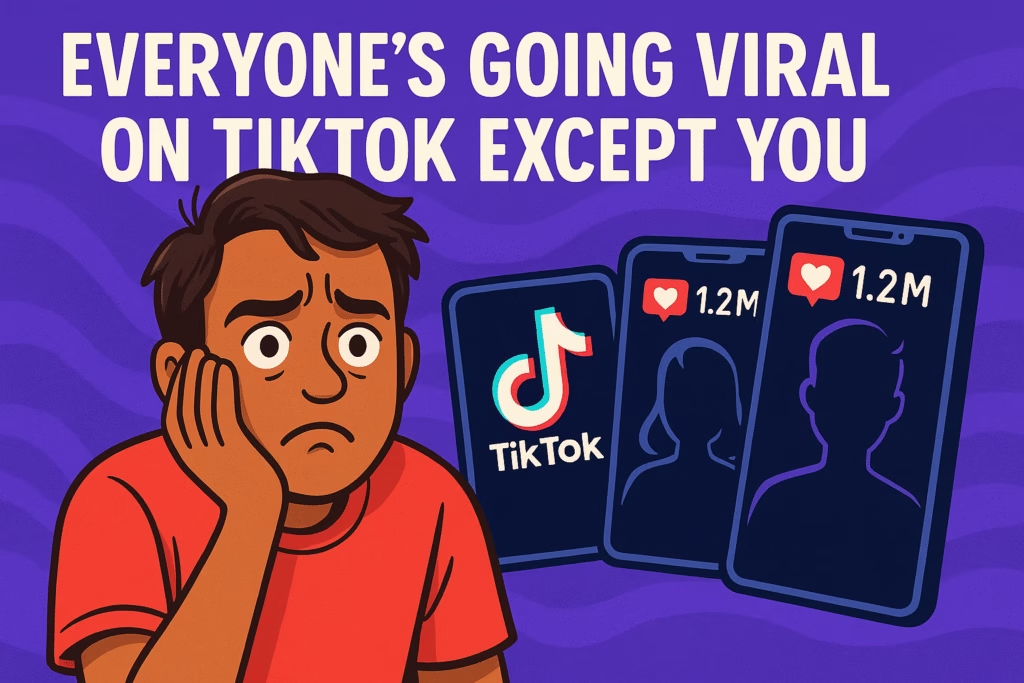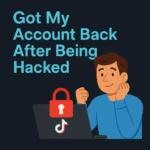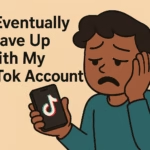Going viral on TikTok used to be easy. TikTok used to be magic. You’d post a clip — boom, 15k views. Drop something clever or relatable? 150k. Now? You’re lucky to scrape together 200.
Meanwhile, the exact same videos — same captions, same edits, same vibe — are pulling 10x more views on YouTube Shorts and Instagram Reels.
One creator in the education space hit 340,000 views on Instagram, while the same video on TikTok barely cracked 450.
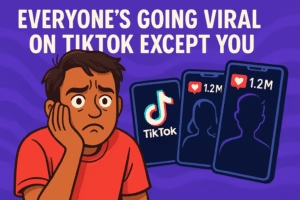
You’re not cursed. You’re not invisible.
But you are playing a game that changed the rules — without telling anyone.
Thousands of creators are watching their TikTok accounts stagnate. They’re posting great content. They’re staying consistent. And still? Nothing.
The problem isn’t your content. It’s how TikTok is distributing it — or rather, how it isn’t.
Here’s what’s really going on under the hood, why creators like you are stuck at 200–500 views, and what smart people are doing to break through.
TL;DR (What’s Really Killing Your Reach)
- TikTok’s current algorithm buries content with low initial engagement. If your post doesn’t hook instantly, it vanishes.
- Viewers behave like a flock. If no one else is liking, most people won’t like. This herd effect amplifies early momentum or kills it.
- The only thing that matters more than likes? Watch time. TikTok ranks content based on how long people watch — but only after showing it to a test audience.
- TikTok is terrible at understanding your audience if you aren’t already niche-famous. It frequently shows your content to the wrong crowd.
- Trends, duets, stitches, and hot-topic videos are the easiest way to get pushed. Posting stand-alone content without trend hooks? Tough sell.
- Some users are faking early likes/comments using engagement pods or bots — and it works, because TikTok sees social proof, not honesty.
- Instagram Reels and YouTube Shorts are better at matching content with relevant viewers — especially if you’re in education, storytelling, or niche humor.
- TikTok isn’t broken. It’s just bloated. There’s more content than distribution. If you want views, you need strategy, audience insight, and platform fluency.
And here’s what most creators overlook: TikTok is now a retention-first platform. Hooking people in 1 second isn’t optional — it’s everything.
How MetaHashtags Can Help
Want a tool that doesn’t just spit out random tags, but actually shows you which ones are banned or oversaturated, and when to post?
MetaHashtags gives small creators a real shot at getting seen without faking engagement or trend-chasing blindly.
It’s like night vision for a dark algorithm.
Ready to dig deeper? Next: how TikTok is showing your content to exactly the wrong people, and how to reverse that.
TikTok Is Showing Your Content to the Wrong People

Let’s address the elephant in the feed:
Your content isn’t bad.
It’s just being served to the wrong audience — and then penalized for not performing well.
This is the core of what’s broken on TikTok in 2025.
The mismatch problem:
TikTok doesn’t care who follows you.
In fact, it doesn’t really use your follower data to determine distribution anymore. It pushes your video to a test group — often totally disconnected from your niche — and waits to see what they do.
If they scroll past?
You’re done. Even if the video would’ve been perfect for your real audience.
And if you’re a new or mid-size creator? TikTok has no idea who your content is for — and no incentive to figure it out.
Creators across Reddit confirm this repeatedly:
“I post edtech videos. Insta knows exactly who to serve them to. TikTok sends them to 15-year-olds who scroll past.”
“My followers don’t see anything anymore. I get comments asking where I’ve been — but I never stopped posting.”
That’s not a visibility bug. It’s the new normal.
TikTok’s audience targeting is weak — unless:
-
You’re selling something through TikTok Shop
-
You’re stitched to a trending topic
-
You already have heavy momentum
Otherwise, TikTok’s test group decides your fate — even if they’re the wrong people entirely.
Compare that with Instagram:
Its interest graph is tighter. If someone watches 3 edtech reels, they’ll get more.
Same on YouTube Shorts. The recommendation engine is actually trained on viewer intent.
TikTok?
It’s still stuck on random scatter-testing. And if your test audience isn’t perfect?
Your video won’t get another chance.
The Herd Effect: Why Your Low-Engagement Video Dies (Even If It’s Good)

Here’s the harsh truth that no one tells new creators:
People don’t just watch content.
They judge it by the numbers — before they even hit play.
This is the herd effect in action.
If a video shows up on someone’s For You Page and it has:
-
3 likes
-
50 views
-
0 comments
…most users will subconsciously assume:
“This must suck. TikTok already knows it’s not worth pushing.”
So they scroll.
It doesn’t matter if the video is high-effort, funny, or even genius.
If it looks socially abandoned, it becomes radioactive.
One Redditor summed it up perfectly:
“Even I hesitate to like a video that has 3 likes. I don’t want my FYP filled with random low-engagement content.”
It’s irrational. It’s unfair.
But it’s real — and it’s killing your videos.
Why TikTok amplifies this
TikTok doesn’t ease new content into the feed gently.
It tosses you into the deep end and sees if strangers bite.
And if the first 50–100 people don’t engage?
Your video is done.
It won’t be reshown. It won’t be re-evaluated.
There’s no second wave of testing.
It just disappears.
This is why fake engagement works
Some creators — especially those on the edge of burnout — have started buying likes or using bots not to cheat their way into virality, but just to avoid the “death spiral” of early low numbers.
Not endorsing it.
Just explaining it.
Because when a video has 50 fake likes? Real users treat it differently.
They give it a chance. They assume it must be decent.
That leads to longer watch time… which leads to more organic reach.
And ironically, that sometimes makes the fake engagement irrelevant — because the real views take over.
Again, not a strategy we recommend.
But if you’ve ever watched a bad video go viral and thought “Why this?”
Now you know.
Watch Time Is King — And You’re Losing in the First 3 Seconds
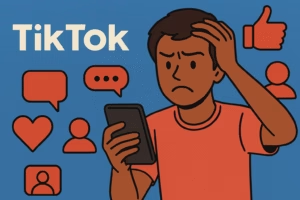
This is where most creators completely misunderstand TikTok’s algorithm.
Likes? Nice to have.
Shares? Cool.
Comments? Sure.
But TikTok doesn’t care about any of those until it knows one thing:
How long are people watching your video?
And more specifically:
How many people stay past 3 seconds?
The cold reality of retention
TikTok’s algo watches viewer behavior like a hawk.
If 30 out of the first 50 people swipe away before the 3-second mark — your video is flagged as weak content. Doesn’t matter if it’s gold after second 4.
The damage is already done.
Most viral videos hook hard — within 0.5 to 1.5 seconds.
They use:
-
Loud statements
-
Visual motion (zoom, color shifts, jump cuts)
-
Text overlays with cliffhangers
-
Faces or reactions
-
Strong emotion, controversy, or humor cues
Meanwhile, most videos that die in the 200–500 range start with:
-
A quiet intro
-
“Hey guys…”
-
An unedited, context-less clip
That’s not content. That’s a feed scroll death sentence.
The new golden rule: Earn every second
Want your video to go beyond test-group hell?
Your first 3 seconds must:
-
Spark curiosity
-
Raise a question
-
Interrupt the scroll
-
Deliver something immediately relatable or valuable
You don’t have time to “build up to the good part.”
TikTok won’t wait. And neither will viewers.
Watch time is king.
And the throne is defended by your hook.
Why Instagram and YouTube Are Eating TikTok’s Lunch
Let’s be brutally honest.
Instagram Reels and YouTube Shorts weren’t supposed to win.
They were TikTok clones — late, clunky, and awkward.
Now?
They’re outperforming TikTok for more and more creators.
And not just boomers.
We’re talking real, active creators in niches like:
- Edtech
- Cooking
- Comedy
- Music
- Gaming
- Pop culture commentary
- Personal stories
Creators are uploading the same exact videos to all platforms — and watching TikTok flop while Reels and Shorts take off.
1. Instagram and YouTube know who your audience is
Meta and Google are scary good at tracking user behavior.
They know what you search, follow, like, and watch across all their apps.
So when you post an educational reel, they’re not guessing who should see it.
They already know.
They’ve built a hyper-detailed interest graph over years.
TikTok?
Still guessing.
Even if you post 50 videos in a niche, TikTok’s audience matching is nowhere near as precise.
2. Reels and Shorts are less bloated
TikTok’s feed is flooded.
Reels and Shorts still have more viewer demand than supply in most niches.
That’s why newer creators say:
“My Reels hit 10k views consistently. TikTok? I’m stuck at 250.”
It’s not just the algorithm.
It’s math.
Less competition = more exposure.
3. TikTok isn’t incentivizing quality anymore
YouTube rewards depth.
Instagram rewards aesthetic and community.
TikTok?
In 2025, it often rewards chaos.
The loudest, weirdest, fastest-moving content — not necessarily the best.
If your videos are smart, thoughtful, or visually clean?
You may be penalized for not being messy enough.
That’s a platform identity crisis — and it’s pushing creators elsewhere.
Strategies That Still Work on TikTok in 2025 (Even for Small Creators)
Let’s stop complaining and start adapting.
Because despite the chaos, TikTok isn’t dead — it’s just evolved.
1. Ride high-volume trends — but remix them
Don’t copy. Remix.
Example:
- A trending audio? Add unexpected text overlays.
- A viral skit format? Flip the punchline.
- A political clip? Stitch it with your own twist.
TikTok rewards familiarity — but only if you layer originality on top.
2. Use duet/stitch formats aggressively
This isn’t 2020 advice. It still works today.
Duets and stitches tap into existing momentum.
They also give your content context — which boosts watch time and retention.
Look for:
- Big creators in your niche
- Controversial takes
- Dumb takes (they’re easier to stitch and subvert)
- Trends you can add expertise to
If your standalone content dies, attach it to something alive.
3. Post at the right time — consistently
No, it’s not everything. But timing helps.
Study your analytics.
If you’re just starting out, test 11 AM, 3 PM, and 8 PM in your local time zone.
Post daily.
But don’t post five times a day unless each one is quality. Spam = algorithm fatigue.
4. Start strong, end stronger
We’ve talked about the first 3 seconds.
But what about the last 3 seconds?
Add:
- A call to comment
- A “what happened next” teaser
- A dramatic pause or jump cut
- A controversial opinion drop
These make people rewatch, share, or hit your profile — which fuels future reach.
5. Use tools that don’t get you flagged
Don’t rely on shady automation or hashtag apps that ping TikTok’s backend.
Use safe tools like:
- MetaHashtags: Spot banned hashtags, plan smart ones, and schedule clean.
- Flick: If you’re managing multiple platforms and need analytics on what’s working.
The TikTok algo may hate you.
But data will always be on your side.
Are You Shadowbanned? Probably Not — But That’s Not the Point

Let’s get this out of the way:
You’re probably not shadowbanned.
Every creator thinks they are.
Most of the time, they’re not.
Here’s what’s actually happening:
- Your video performed poorly with the test audience
- TikTok stopped distributing it
- You assumed it was punishment — when it was just math
That said, TikTok is horrible at communicating when (or why) distribution drops off.
So it feels like a ban.
It smells like a ban.
It acts like a ban.
But it’s not.
1. Low retention on multiple videos in a row
TikTok doesn’t penalize you for one flop.
But if you post five videos in a row with terrible watch time?
The algo starts assuming your content isn’t worth testing.
That’s what feels like a shadowban.
2. Wrong audience targeting (again)
If your views are capped at 200–300, and all your comments are from randoms outside your niche?
You’re not banned.
You’re just misclassified.
Fix this by:
- Posting 3–5 videos in the same exact style
- Using niche hashtags
- Responding to comments to signal community relevance
3. Flagged hashtags or captions
This one’s real.
Using certain banned or spammy hashtags (even accidentally) can suppress your reach.
Avoid:
- NSFW-adjacent tags
- Giveaway or promo spam tags
- Overused trends that have been throttled
Use a tool like MetaHashtags to check what’s actually safe.
Final Thoughts: You’re Not Broken — The Algorithm Is
If you’ve made it this far, here’s what you need to hear:
It’s not you.
It’s not your content.
It’s not your voice, your face, your captions, or your niche.
It’s TikTok.
TikTok’s algorithm in 2025 is messy, inconsistent, and brutally harsh on new and mid-size creators.
It favors early momentum over actual quality.
It buries niche content.
It mislabels your audience.
And it gives zero second chances.
But it’s not hopeless.
Creators are going viral.
Creators are breaking through the 200-view curse.
They’re just not doing it by luck anymore. They’re doing it with strategy.
So if you’ve been:
- Posting daily
- Editing like a pro
- Recycling content that’s blowing up on Reels or Shorts
… and still getting nowhere?
Stop guessing. Start optimizing.
Use smart tools. Study the first 3 seconds. Stitch like a savage.
Play TikTok like a platform — not a lottery.
Because right now? It’s not the best content that wins.
It’s the content that knows how to play.
